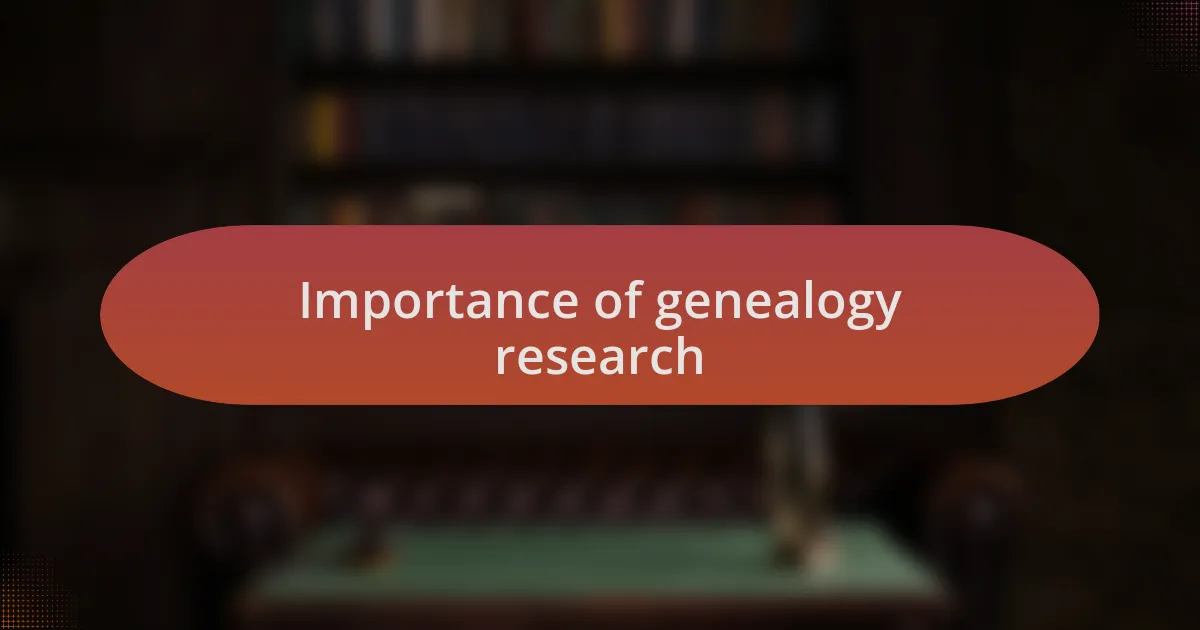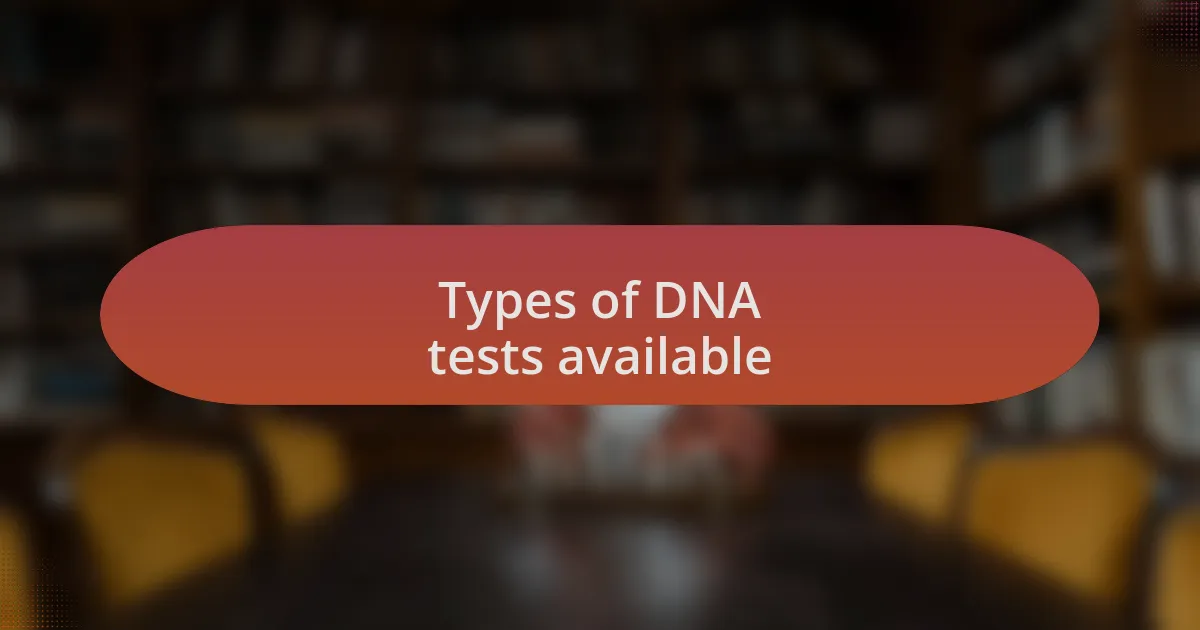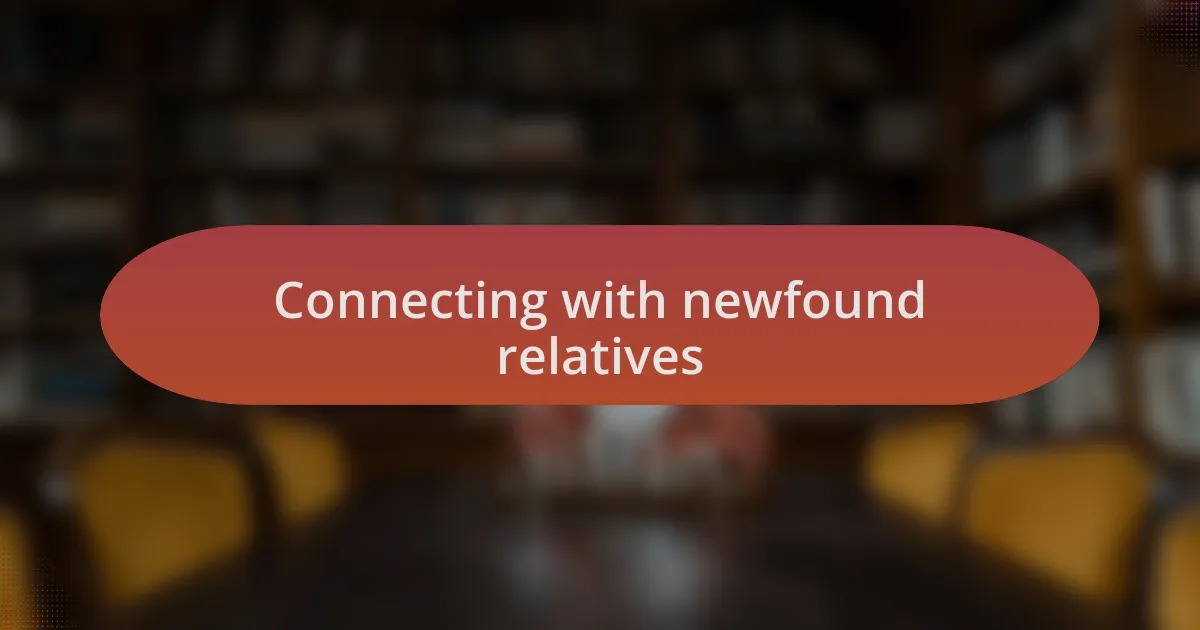Key takeaways:
- DNA testing reveals ancestral connections and can evoke strong emotions related to identity and family history.
- Genealogy research provides personal insight into family stories, enhancing a sense of belonging and understanding of historical context.
- Different types of DNA tests (autosomal, mitochondrial, Y-DNA) serve distinct purposes in exploring heritage and relationships.
- Connecting with newfound relatives can lead to emotional bonds and collaborative efforts to document family history.

Understanding DNA testing
DNA testing has become a fascinating doorway to our ancestral roots, unraveling stories hidden in our genes. I remember when I first decided to take a DNA test, feeling an exhilarating mix of curiosity and apprehension. The thought of uncovering unexpected relatives or long-lost heritage stirred something deep within me.
It’s incredible to think that a simple saliva sample can reveal so much about who we are. Have you ever wondered why you might feel a connection to a particular culture or place? My own results unexpectedly linked me to regions I had never considered, igniting a spark of curiosity that pushed me to explore these newfound connections beyond just a name on a family tree.
Understanding DNA testing also involves grappling with the ethical dimensions of our discoveries. Navigating potential surprises, like finding out about unknown family members, can be a roller coaster of emotions. When I learned about a cousin I never knew existed, I felt a mix of excitement and apprehension—what would this mean for my family narrative? It’s essential to approach these revelations with both an open heart and mind, acknowledging the complexity of what we may uncover.

Importance of genealogy research
Genealogy research is not just about tracing back family names and dates; it’s about connecting with our past on a deeply personal level. I often find myself reflecting on how learning about my ancestors’ struggles and triumphs can influence my own outlook on life. Have you ever considered how knowing your family’s stories could inspire you to overcome challenges? Understanding where we come from not only enriches our identity but also strengthens our sense of belonging in this world.
Delving into genealogy helps us uncover hidden narratives that may shift our perspective on history. I remember feeling a profound connection when I discovered a relative who fought in a significant historical event. It made history feel tangible and personal. How often do we hear about historical figures without realizing we might be related to them? This revelation added a layer of meaning to my life and made history come alive in ways I never expected.
Moreover, genealogy can strengthen familial bonds by fostering conversations about shared heritage. I’ve seen how discussing our findings with family members reignited pride in our lineage, especially among younger generations. Have you thought about how these discussions can bridge gaps across generations? As we share stories, we create a tapestry of experiences that honor our ancestors while instilling a sense of responsibility to carry their legacy forward.

How DNA testing works
DNA testing is a fascinating process that involves analyzing specific markers in our genetic material to uncover insights about our ancestry. When I first tried it, I was amazed to see how a simple saliva sample could unlock a treasure trove of information about my family’s history. Have you ever thought about how just one test can connect you with relatives you’ve never met?
The science behind DNA testing relies on examining our genetic code, which is made up of sequences of nucleotides. These sequences can reveal not only our ethnic background but also potential genetic traits inherited from our ancestors. I remember the moment I received my results; learning about my genetic ties to different regions was surreal. Did you know that specific markers can also indicate health predispositions?
As DNA is passed down through generations, it encapsulates a record of our family’s journey. Each strand tells a story of migration, adaptation, and survival—stories I never imagined I carried within me. Reflecting on my results, I felt a sense of belonging to a lineage that stretches back in time. How much more connected do you feel when you realize there are echoes of your ancestors living within your own cells?

Types of DNA tests available
DNA testing encompasses several types, each serving a unique purpose in exploring our ancestry. The three primary categories include autosomal DNA tests, mitochondrial DNA tests, and Y-DNA tests. When I first learned about these distinctions, it was fascinating to see how they could illuminate different aspects of my heritage. Have you ever considered what secrets lie within each type of test?
Autosomal DNA tests are the most common and analyze chromosomes inherited from both parents. They provide a comprehensive overview of your ethnic makeup and identify potential relatives within a specified range of relationships, making it an excellent option for those looking to build their family tree. I remember connecting with a third cousin through an autosomal test and how that revelation added another branch to my family history. Isn’t it astounding how one test can expand your understanding of your network of relatives?
On the other hand, mitochondrial DNA tests trace maternal lineage, passing down through generations of women, while Y-DNA tests focus exclusively on the paternal line, only available to males. These tests reveal deeper ancestral lines and can even uncover ancient migrations. When I explored my maternal line through mitochondrial testing, I discovered connections to regions I never expected. Have you thought about how exploring these paths can reshape your identity?

Case studies of family discoveries
One particularly compelling case study involved a woman named Sarah who, after using an autosomal DNA test, unearthed a half-sister she never knew existed. The emotional revelation shook her world; growing up as an only child, she yearned for connection. Exploring this new relationship illuminated not just the gaps in her family tree, but also her own feelings of solitude. It made me reflect—how often do we overlook the potential of these connections?
In another instance, a man named David discovered he was adopted when he took a Y-DNA test, which unexpectedly connected him with a biological family. His initial shock was overwhelming, but the eventual journey into his roots offered a profound sense of belonging he hadn’t realized he was missing. The day he met his biological father was filled with a mix of anxiety and excitement. Don’t you think such emotional discoveries can truly redefine who we are?
Lastly, consider the case of a couple who, through mitochondrial DNA testing, traced their ancestry back to a small village in Italy. This discovery inspired them to embark on a journey to visit their ancestral home, where they met distant relatives who welcomed them with open arms. The ties of family transcended years of separation, proving that even the smallest DNA match can lead to life-changing experiences. Have you ever thought about how a simple test could open doors to a whole new world?

Tips for using DNA results
Understanding how to use DNA results effectively can amplify your genealogical research. One tip is to take the time to thoroughly analyze your matching list. When I first delved into my results, I was overwhelmed by the number of potential relatives. But as I began reaching out to those with shared matches, I discovered connections that illuminated branches of my family tree I never knew existed. It’s amazing how each match can potentially unfold a story waiting to be told.
Another strategy involves contacting matches to share information. I remember reaching out to a third cousin, and our exchange felt electric. It’s not just about names and dates; it’s about the history, the shared experiences, and maybe even family traditions that may have been lost over generations. Have you considered that a simple email could lead to the discovery of family stories that enrich your understanding of your roots?
Lastly, don’t forget to utilize third-party tools for deeper insights. I’ve found platforms that allow for customizable family trees and the integration of historical records quite helpful. It’s a game changer when you can see how your DNA matches fit into broader historical contexts. Plus, have you thought about how intriguing it is to watch your family tree grow as new connections emerge? Every step deepens the narrative of who we are.

Connecting with newfound relatives
As I started connecting with newfound relatives, I was taken aback by the warmth of their responses. One particular evening, I received a message from a distant cousin who had not only researched our shared ancestry but also shared captivating stories about our ancestors’ lives. It was a surreal experience, almost like discovering a piece of myself I didn’t know was missing.
Building these relationships often sparks unexpected emotional bonds. I remember when a newfound relative sent me an old family photograph I had never seen before; it felt as if I had been gifted a part of my heritage. Have you ever felt that shiver of recognition when a stranger becomes a part of your story? Each connection opens doors to conversations that go beyond simple facts, weaving a tapestry of shared identity.
The thrill of connecting with newfound relatives is also about collaboration. I recall teaming up with a cousin to create a family history book that not only documented our lineage but also preserved our family stories for future generations. Have you explored how working together can amplify your family narrative? By combining our research efforts, we transformed a solitary journey into a shared adventure, enriching our understanding of where we come from.